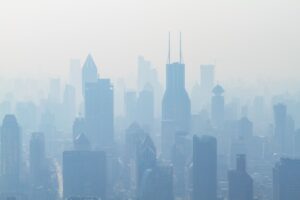Introduction:
Air pollution is a serious concern that can affect our health, particularly for older adults. Fine particulate matter, known as PM2.5, is a type of air pollution with tiny particles that can enter our lungs and cause various health issues. While we know that PM2.5 can be harmful, our understanding of how specific components and sources of PM2.5 impact mortality is limited. In this article, we will explore a study by Fatemeh Kazemiparkouhi and team from Tufts University, USA, that investigated the associations between long-term exposure to different PM2.5 components and sources with cause-specific mortality in older adults across the United States.
The Study:
The researchers analyzed data from 15.4 million older adults covered by Medicare living in the contiguous United States between 2000 and 2008. They examined the PM2.5 exposure for each beneficiary, focusing on its different constituents and sources. To understand these associations, they used advanced statistical methods like factor analysis and residual-based approaches.
Results:
The study found that certain PM2.5 constituents were associated with higher mortality rates from specific causes. Notably, PM2.5 components related to coal combustion and traffic showed the strongest associations with various causes of death, including cardiovascular disease (CVD), respiratory disease, and cancer. Additionally, metal-related PM2.5 components, such as lead (Pb), were linked to increased overall mortality rates, excluding deaths from chronic obstructive pulmonary disease (COPD) and lung cancer. Nitrate (NO3-) and silicon (Si), along with their associated source-related PM2.5 components (traffic and soil, respectively), were also significantly associated with higher mortality rates for all-cause, CVD, respiratory diseases, and all cancers.
The researchers observed that the impact of PM2.5 on mortality varied among different groups of beneficiaries. Minority populations, especially Black individuals, low-income urban residents, younger individuals, and men experienced greater mortality hazards from PM2.5 exposure.
Moving Forward
The study highlights the significant health risks associated with long-term exposure to certain PM2.5 components and sources. Air pollution from coal combustion and traffic was particularly harmful, contributing to cardiovascular disease, respiratory issues, and cancer-related deaths. It also emphasizes the importance of considering the demographic and location factors when assessing the impact of air pollution on health.
Conclusion:
Air pollution, especially PM2.5, poses a serious threat to older adults’ health, increasing the risk of mortality from various causes, including cardiovascular disease, respiratory diseases, and cancer. The study provides valuable insights into the specific components and sources of PM2.5 that are most harmful to health, helping us better understand and address the health risks associated with air pollution.
Implications:
The findings from this study have important implications for public health policies and practices. Efforts to reduce PM2.5 emissions from sources like coal combustion and traffic could significantly improve older adults’ health and reduce mortality rates. Additionally, targeting interventions in areas with high PM2.5 exposure, especially among vulnerable populations like minority and low-income communities, can help protect those most at risk.
Further Research:
While this study provides crucial information, there is still much to learn about the complexities of air pollution and its impact on health. Further research is needed to explore other PM2.5 constituents and sources and their associations with mortality. Moreover, understanding the biological mechanisms underlying these associations can guide the development of more targeted and effective public health strategies.
In conclusion, addressing air pollution, particularly PM2.5, is a critical step in safeguarding the health and well-being of older adults and vulnerable populations. By implementing evidence-based policies and promoting clean air initiatives through governments and private entities, we can create healthier environments for everyone, reducing the burden of diseases linked to air pollution and working towards a healthier and sustainable future.







